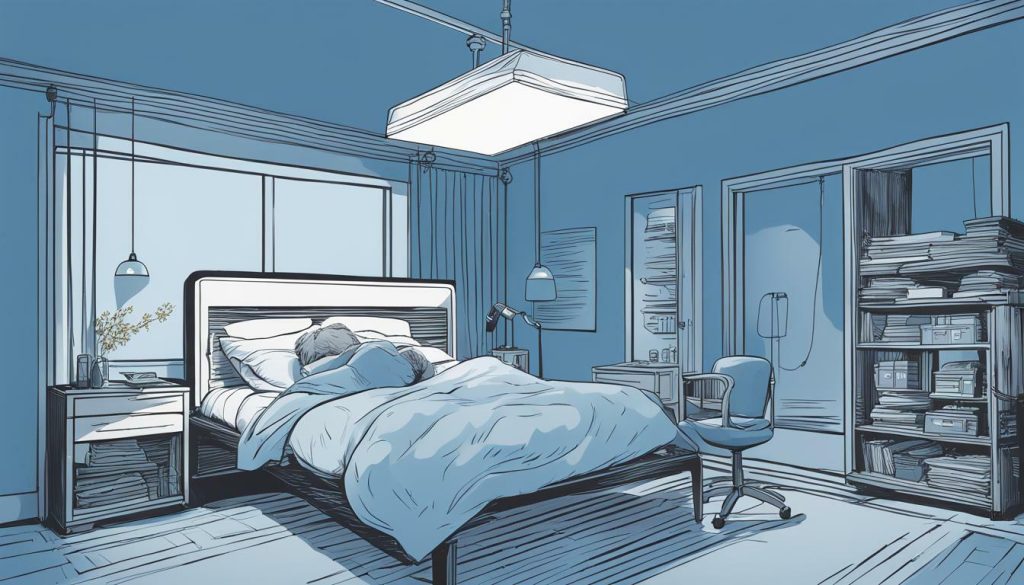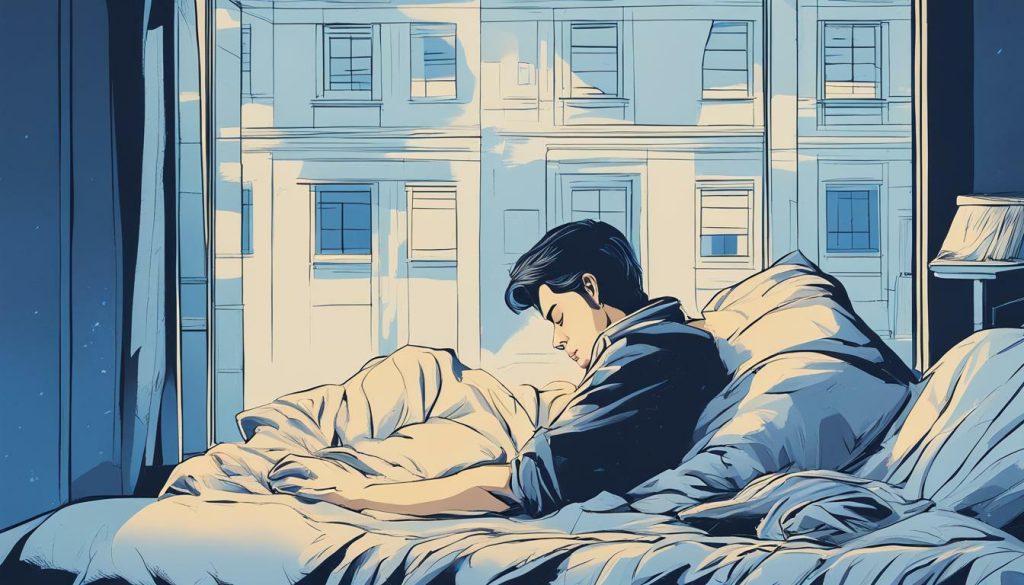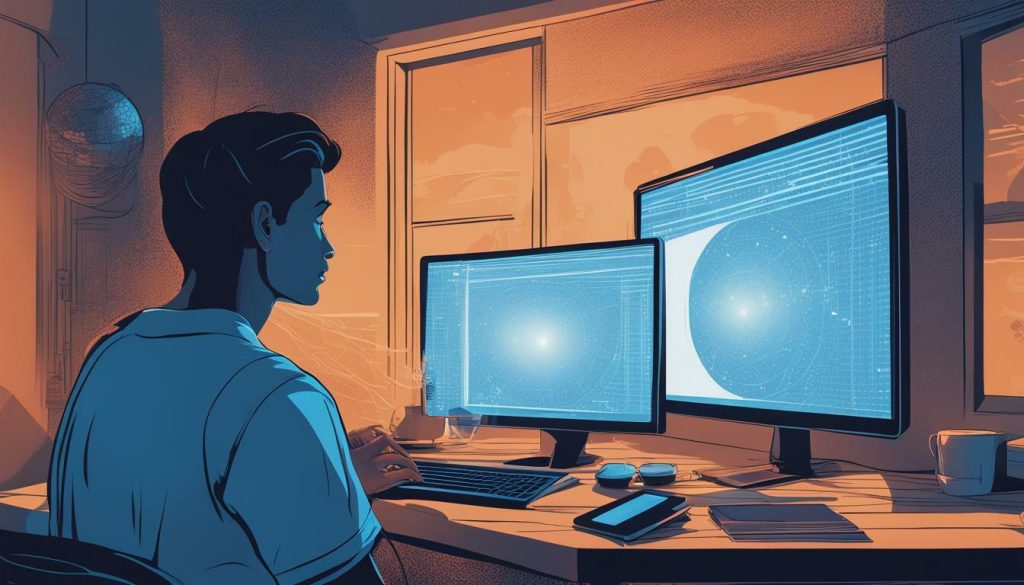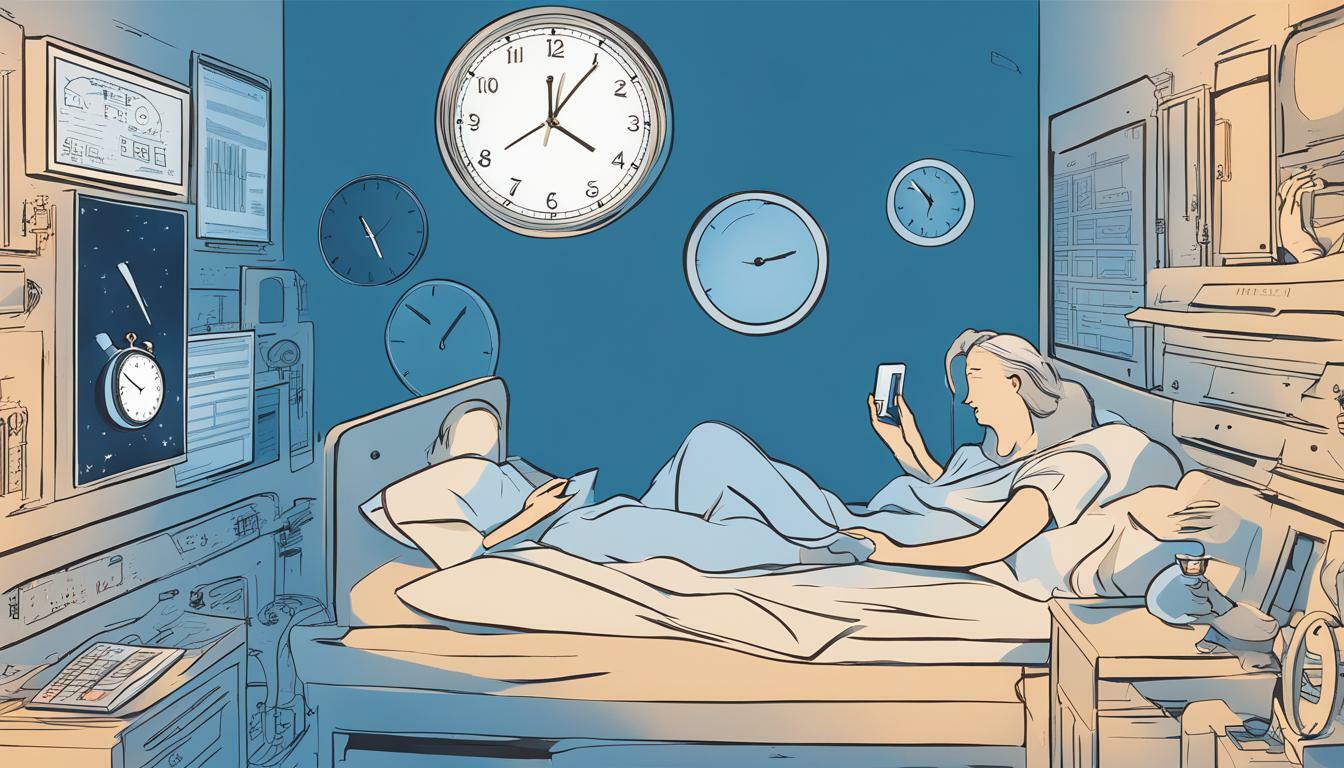If you’ve ever struggled with jet lag or had trouble sleeping after a night of watching TV or scrolling through your phone, you may have experienced the effects of blue light on your circadian rhythm. But what exactly is blue light and how does it impact our internal body clock?
Blue light is a type of light on the visible spectrum that has a short wavelength and high energy. It is naturally present in sunlight and can also be emitted by electronic devices such as smartphones, tablets, and laptops. Blue light exposure can affect our circadian rhythm, which is the 24-hour internal clock that regulates our sleep-wake cycle, hormone production, and other physiological processes.
Key Takeaways:
- Blue light is a type of light on the visible spectrum that can affect our internal body clock.
- Blue light exposure can disrupt our circadian rhythm, which can lead to sleep problems and other health issues.
- Managing blue light exposure is important for maintaining a healthy circadian rhythm and promoting optimal sleep health.
Understanding Circadian Rhythm and Blue Light
Our bodies operate on a 24-hour internal clock, known as the circadian rhythm. This biological process regulates our sleep-wake cycle, hormone production, and other physiological functions.
Exposure to light, particularly blue light, plays a significant role in regulating the circadian rhythm. Blue light is a short-wavelength, high-energy light that is commonly emitted by electronic devices, LED lights, and the sun.
When our eyes detect blue light, it signals to the brain that it is daytime and time to be awake and alert. Conversely, when our eyes detect darkness, it signals to the brain that it is nighttime and time to sleep.
However, excessive or improper exposure to blue light, particularly in the evening and before bedtime, can disrupt the circadian rhythm and negatively impact sleep quality. This is because blue light suppresses the production of melatonin, a hormone that regulates sleep and wakefulness.
In recent years, blue light has become a growing concern, as more and more people are exposed to it through electronic devices and other sources late into the night. In the next sections, we will explore the effects of blue light on circadian rhythm and strategies for optimizing sleep health through effectively managing blue light exposure.

The Effects of Blue Light on Circadian Rhythm
Blue light is a specific type of light with a short wavelength that is highly influential in regulating the body’s circadian rhythm, or internal clock. Exposure to blue light has both positive and negative effects on the circadian rhythm, depending on the timing and duration of exposure.
One of the primary effects of blue light on the circadian rhythm is its impact on melatonin production. Melatonin is a hormone that is responsible for regulating sleep-wake cycles, and its production is suppressed by exposure to blue light. This means that exposure to blue light in the evening or at night can interfere with the body’s ability to produce melatonin, leading to difficulty falling or staying asleep.
Research has also shown that excessive exposure to blue light can disrupt the timing and quality of the sleep-wake cycle, leading to sleep disorders like insomnia and sleep apnea. This is because blue light exposure can suppress the production of other hormones that are involved in regulating the circadian rhythm, such as cortisol and serotonin.

However, blue light exposure can also have positive effects on the circadian rhythm when timed and managed appropriately. Exposure to blue light in the morning and during the daytime can help to reset and synchronize the body’s internal clock, promoting wakefulness and alertness during the day and better sleep quality at night.
It is important to be mindful of the amount and timing of blue light exposure in order to optimize circadian rhythm and promote healthy sleep. This may involve limiting exposure to blue light in the evening and before bedtime, using blue light filters on electronic devices, and incorporating exposure to natural light during the day.
Overall, blue light plays a significant role in regulating the body’s circadian rhythm, and managing its impact is crucial for promoting optimal sleep health and overall well-being.
Optimizing Circadian Rhythm with Blue Light
Blue light has been found to be particularly effective in regulating circadian rhythm and promoting optimal sleep health. By understanding its effects on the body’s internal clock, it is possible to optimize circadian rhythm using blue light in a number of ways. Optimizing circadian rhythm with blue light involves a combination of exposure to natural light, light therapy devices, and managing blue light exposure in the evening and before bedtime.
Exposure to Natural Light
Exposure to natural light, particularly in the morning, has been shown to help regulate circadian rhythm and improve sleep quality. Spending time outdoors during the day, or positioning yourself near a window with sunlight, can help reset your body’s internal clock to match the natural light-dark cycle.
For those who work indoors or have limited access to natural light, light therapy devices can also be used to simulate natural light exposure. These devices emit bright, blue-enriched light that can help regulate circadian rhythm and improve sleep quality.
Light Therapy Devices
Light therapy devices are commonly used to treat circadian rhythm disorders, such as delayed sleep phase syndrome and non-24-hour sleep-wake disorder. These devices typically emit blue light in the morning to help reset the body’s internal clock, and red light in the evening to promote relaxation and prepare the body for sleep.
There are several different types of light therapy devices available, including lamps, light boxes, and wearable devices. It is important to speak with a healthcare professional before using light therapy, as it may not be appropriate for everyone.
Managing Blue Light Exposure
Managing blue light exposure in the evening and before bedtime is also crucial for optimizing circadian rhythm and promoting healthy sleep habits. Exposure to blue light from electronic devices such as smartphones, computers, and televisions can suppress melatonin production and disrupt the sleep-wake cycle.
To minimize the impact of blue light on circadian rhythm, it is recommended to avoid using electronic devices for at least 30 minutes before bedtime. Additionally, using blue light blocking glasses or applying a blue light filter to electronic devices can help reduce the amount of blue light exposure in the evening.

Optimizing circadian rhythm with blue light is crucial for maintaining overall health and well-being. By incorporating exposure to natural light, using light therapy devices, and managing blue light exposure, it is possible to regulate circadian rhythm and promote healthy sleep habits.
Blue Light Therapy for Circadian Rhythm
For individuals with circadian rhythm disorders or other sleep-related issues, blue light therapy may offer an effective treatment option. This therapy involves exposure to artificial blue light at specific times of the day to reset the body’s internal clock and promote healthy sleep-wake cycles.
The therapy typically involves the use of specialized light therapy devices, such as light boxes or glasses, which emit a controlled amount of blue light at specific wavelengths. These devices are designed to simulate natural outdoor light, and can be used at home or in a clinical setting.
Research suggests that blue light therapy can be particularly effective for individuals with delayed sleep phase syndrome, a condition characterized by a delayed sleep-wake cycle that can result in difficulty falling asleep at night and excessive daytime sleepiness. Studies have also shown that the therapy can be helpful for individuals with other types of circadian rhythm disorders, such as shift work disorder or jet lag.
| Benefits of Blue Light Therapy for Circadian Rhythm: |
|---|
| 1. Regulation of melatonin production: Exposure to blue light at specific times of the day can help regulate the body’s production of melatonin, a hormone that plays a crucial role in promoting healthy sleep. |
| 2. Improved sleep quality: By resetting the body’s internal clock, blue light therapy can help improve the quality of sleep, leading to increased energy and alertness throughout the day. |
| 3. Non-invasive treatment: Unlike some other treatments for circadian rhythm disorders, such as medication or surgery, blue light therapy is non-invasive and free from side effects. |
It is important to note that blue light therapy should only be used under the guidance and supervision of a qualified healthcare professional. Improper or excessive use of the therapy can lead to negative side effects, including eye strain, headaches, and disruption of the sleep-wake cycle.

If you are considering blue light therapy for a circadian rhythm disorder or other sleep-related issue, talk to your healthcare provider to determine if it is a safe and appropriate treatment option for you.
Managing Blue Light Exposure for Optimal Sleep Health
While blue light plays an important role in regulating the circadian rhythm, excessive or improper exposure can have negative effects on sleep quality and overall health. Here are some practical tips for managing blue light exposure:
- Avoid using electronic devices, such as smartphones and tablets, for at least an hour before bedtime. If you must use these devices, consider using apps that filter out blue light or wearing blue light blocking glasses.
- Use warm, dim lighting in the bedroom in the evening to signal to the brain that it is time for sleep. Avoid bright, cool-toned lighting that can disrupt the sleep-wake cycle.
- Get exposure to natural daylight in the morning, as this can help regulate the body’s internal clock. Try to spend time outside or near a window in the morning, or consider using a light therapy device.
By implementing these strategies, you can help optimize your circadian rhythm and improve your overall sleep health.

The Importance of Blue Light for Circadian Rhythm
Blue light plays a critical role in regulating our internal clock, also known as our circadian rhythm. This natural 24-hour cycle helps our body know when it’s time to be awake and alert, and when it’s time to wind down and rest. Exposure to blue light, particularly in the morning and during the day, helps to keep our circadian rhythm in sync and functioning optimally.
Research has shown that blue light exposure can improve mood, cognitive function, and overall well-being. In fact, it’s even been found to help alleviate symptoms of seasonal affective disorder (SAD).
One of the most important functions of blue light is its impact on melatonin production. Melatonin is a hormone that helps regulate our sleep-wake cycle, and exposure to blue light suppresses its production. This is why exposure to blue light in the evening and before bedtime can disrupt our circadian rhythm and make it harder to fall asleep.
However, it’s important to note that not all blue light is bad for us. In fact, exposure to natural blue light during the day can be highly beneficial. Natural blue light is found in sunlight, and it helps to regulate our circadian rhythm and promote wakefulness.
By understanding the important role that blue light plays in our circadian rhythm, we can take steps to optimize our exposure and promote better sleep health. This includes being mindful of our blue light exposure throughout the day, and using strategies like light therapy devices to regulate our circadian rhythm.
Overall, the importance of blue light for our circadian rhythm cannot be overstated. It’s essential for our body to function optimally and for us to feel our best. By managing our exposure to blue light and incorporating it into our daily routine in a healthy way, we can support our circadian rhythm and promote overall well-being.

Circadian Rhythm Disruption and Blue Light
While exposure to blue light during the day is beneficial for regulating the circadian rhythm, excessive exposure to blue light at night can disrupt it. This disruption can have negative effects on sleep quality and overall health.
Research has shown that blue light exposure before bedtime can suppress the production of melatonin, a hormone that helps regulate sleep-wake cycles. This can lead to difficulty falling asleep and staying asleep.
In addition, circadian rhythm disruption has been linked to a range of health issues, including obesity, diabetes, and cardiovascular disease.
Unfortunately, many modern devices emit high levels of blue light, including smartphones, laptops, and televisions. This means that many people are unknowingly exposing themselves to blue light late into the evening, which can negatively impact their circadian rhythm.
To minimize the risk of circadian rhythm disruption, it is important to limit exposure to blue light in the evening and before bedtime. This can be done by using a blue light filter on electronic devices, avoiding stimulating activities such as watching TV or using the computer, and keeping the bedroom dark and quiet.
By taking steps to manage blue light exposure, individuals can promote a healthy circadian rhythm and improve their overall sleep health.

Blue Light and the Sleep-Wake Cycle
Exposure to blue light has a significant impact on the sleep-wake cycle and the body’s internal clock, making it crucial for managing circadian rhythm. Blue light stimulates photoreceptors in the eye, which trigger the suprachiasmatic nucleus (SCN) to regulate the release of melatonin.
Melatonin is a hormone that plays a crucial role in the sleep-wake cycle, signaling to the body when it is time to sleep.
When blue light exposure is excessive, particularly in the evening and before bedtime, it can delay the release of melatonin, causing difficulty falling asleep and disrupting the sleep-wake cycle. Research has also linked blue light exposure at night with increased risk of sleep disorders and other health implications.
It is important to manage blue light exposure, particularly in the evening and before bedtime, to promote better sleep quality and maintain a healthy circadian rhythm. Techniques such as using light therapy devices or incorporating exposure to natural light during the daytime can help optimize circadian rhythm. Additionally, avoiding the use of electronic devices, such as laptops and smartphones, before bedtime can limit exposure to blue light and promote better sleep quality.

Conclusion
In conclusion, the impact of blue light on our circadian rhythm cannot be understated. As we have discussed throughout this article, exposure to blue light can have both positive and negative effects, depending on the timing and duration of exposure.
Optimizing our circadian rhythm through the appropriate use of blue light is critical for maintaining good sleep health and overall well-being. Strategies such as light therapy devices, exposure to natural light, and managing blue light exposure in the evening can all be effective in regulating our internal clock.
However, it’s important to remember that excessive or improper exposure to blue light can disrupt our circadian rhythm, leading to sleep disorders and other negative health implications. Therefore, it’s essential to manage blue light exposure carefully, particularly before bedtime.
Ultimately, the key takeaway from this article is the vital role that blue light plays in maintaining our circadian rhythm and promoting optimal sleep health. By understanding and managing our exposure to blue light, we can improve our overall well-being and enjoy more restful, rejuvenating sleep.
FAQ
Q: What is the role of blue light in regulating the circadian rhythm?
A: Blue light has a significant impact on the circadian rhythm, playing a crucial role in regulating sleep-wake cycles and overall well-being.
Q: How does exposure to blue light affect the circadian rhythm?
A: Exposure to blue light can disrupt the circadian rhythm, particularly in the evening and before bedtime, leading to sleep disorders and other health implications.
Q: What are some strategies for optimizing circadian rhythm with blue light?
A: Strategies for optimizing circadian rhythm with blue light include using light therapy devices, incorporating exposure to natural light, and managing blue light exposure in the evening.
Q: What is blue light therapy and how does it impact circadian rhythm?
A: Blue light therapy is a specific treatment for circadian rhythm disorders that utilizes blue light to regulate sleep-wake cycles. It can be effective but may also have potential risks.
Q: What are some practical tips for managing blue light exposure for better sleep health?
A: Practical tips for managing blue light exposure include limiting screen time before bed, using blue light filters on electronic devices, and creating a sleep-friendly environment.
Q: Why is blue light important for maintaining a healthy circadian rhythm?
A: Blue light is important for maintaining a healthy circadian rhythm because it helps regulate the body’s internal clock and supports overall well-being.
Q: What are the potential negative effects of excessive blue light exposure on circadian rhythm?
A: Excessive blue light exposure can disrupt the circadian rhythm, leading to sleep disorders, daytime fatigue, and other health implications.
Q: How does blue light impact the sleep-wake cycle?
A: Blue light affects the sleep-wake cycle by suppressing melatonin production, delaying sleep onset, and altering the body’s internal clock.

